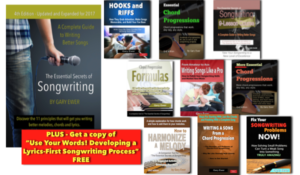Good songs don’t follow rules; it’s more a case of following guidelines. That means that every time you think you’ve identified a songwriting “rule”, you can come up with a list of songs that don’t follow it.
Here’s a good example: if you look at a hundred different songs and try to identify the characteristics of, let’s say, a good song hook, you’ll come up with these:
- It’s short and catchy.
- It’s fun to repeat over and over again.
- It can be harmonized by a simple, tonally strong chord progression.
- Its melody is mainly stepwise but usually with an interesting melodic leap.
- It’s got an interesting rhythm, often using a syncopation.
The first two characteristics are pretty safe ones to assume. It wouldn’t be much of a hook if it wasn’t catchy and fun to repeat.
 In the pop genres, a song can live or die based on the quality of the hook. Discover the secrets of how to make your hook work better in this eBook: “Hooks and Riffs: How They Grab Attention, Make Songs Memorable, and Build Your Fan Base.” It’s part of “The Essential Secrets of Songwriting 10-eBook Bundle”
In the pop genres, a song can live or die based on the quality of the hook. Discover the secrets of how to make your hook work better in this eBook: “Hooks and Riffs: How They Grab Attention, Make Songs Memorable, and Build Your Fan Base.” It’s part of “The Essential Secrets of Songwriting 10-eBook Bundle”
The next three are the real backbone of a good song hook. It’s hard to find a song hook that isn’t harmonized by a simple, tonally strong chord progression, but that’s mainly because most pop genres and subgenres all use pretty simple chord progressions. I’m sure there must be one or two out there, though, that have a chorus hook that’s a bit adventurous.
And it is generally true that a hook’s melody is usually stepwise with an interesting leap, but not always. The chorus hook for Lennon & McCartney’s “All You Need Is Love”, for example, all sits on one pitch.
The last characteristic on that list — the interesting rhythm — is another one that’s very common, and here’s something worth noting: if a song hook sits mainly in and around one or two pitches, with no interesting melodic leap, it makes having the interesting rhythm all the more important.
And again, “All you Need Is Love” is a great demonstration of this. The chorus hook that incorporates the title of the song has an interesting rhythm, with a couple of syncopations:

In other words, the aspects of interesting melody and interesting rhythm often pair up as an important partnership in a song hook. The more active the melody, the less vital a syncopated rhythm is. The more active the rhythm, the less important the melody is.
Think of a song like “Let the Sun Shine” from the 5th Dimension’s medley from 1969. It’s repeated over and over: that part of the medley is comprised entirely of a hook. The melody is static, barely moving off the tonic note. It’s the rhythm that makes the hook interesting.
The start of the chorus of Adele’s “Hello” (“Hello from the other side…“) uses a melody that is much more animated — a kind of inverted U-shaped melody, and the rhythm is much simpler — mainly eighth notes with no syncopation.
In a way, it’s a kind of principle that doesn’t get mentioned a lot in songwriting manuals, which is that as one element steps forward, others step back in a bid to avoid upstaging something more important.
Good hooks will have those five characteristics mentioned earlier in this post, but that’s not to say that they all are equally important in any one song. As always, use your musical judgment to decide which aspects are more important, and then let the others move into the background a bit.
 Written by Gary Ewer. Follow Gary on Twitter.
Written by Gary Ewer. Follow Gary on Twitter.
 “The Essential Secrets of Songwriting” eBook bundle includes“Writing a Song From a Chord Progression”. Discover the secrets of making the chords-first songwriting process work for you.
“The Essential Secrets of Songwriting” eBook bundle includes“Writing a Song From a Chord Progression”. Discover the secrets of making the chords-first songwriting process work for you.










